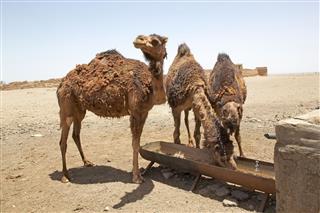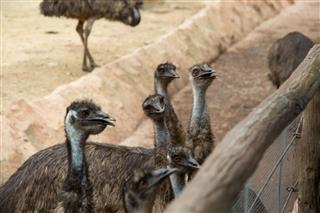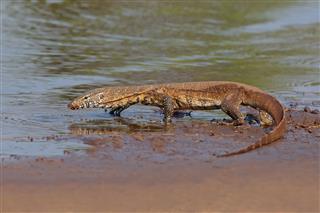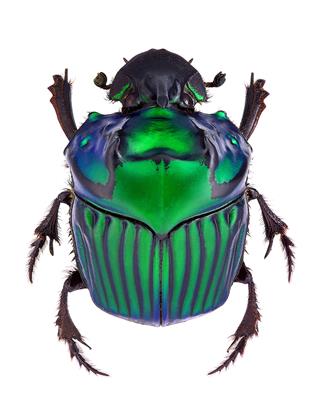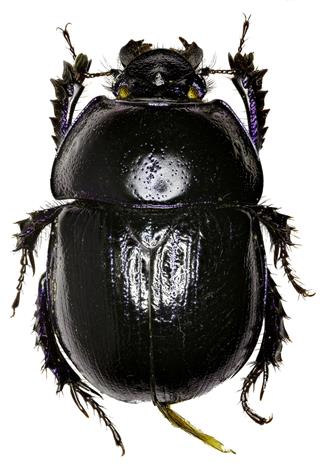
The Sahara Desert is the largest hot desert in the world and the third largest desert (area wise) falling right after Antarctica and the Arctic. The climatic and geographical conditions makes it one of the very harsh and inhabitable regions on the planet.
Life in the Sahara desert must be tough. It is a huge desert, hot and dry during the day, while the nights are cold and windy. There is no sign of food or drinking water for miles together. Only sand and more sand, as far as the eye can see.
In such a difficult terrain live animals that boggle our minds with the sheer temerity they show in the face of harsh conditions. These animals are an inspiration to even the most cynical of human beings.
Animals of the Sahara Desert
The animals that currently inhabit the Sahara desert are some of the oldest species in the world. Of course, most of them have undergone some level of adaptation so that they are able to survive in the harsh desert. As such, compared to animals in the other parts of the world, obviously their diet and way of living also differs.
Addax Antelope
The Addax Antelope are flat-footed antelopes that can easily traverse the sandy landscape of the Sahara. Umfortunately, this antelope is on the way to extinction. Reasons for this include heavy poaching for their meat and leather, along with deteriorating habitat due to human encroachment and global warming. They are rather slow because of their size and their flat hooves, making it all the more difficult for them to run from predators.
Dromedary Camel
When one thinks of a desert, the first thing that comes to the mind is a camel. The Dromedary camel, which is said to be of Arabian origin, is the main Saharan camel. The interesting thing about these camels is that they store fat in their humps, and not water. They can drink up to 100 liters of water in 10 minutes flat. They make great domesticated animal in the Saharas’, as they have great strength, endurance, and can go without water and food for a very long time.
Dorcas Gazelle
It is the most common species of gazelle, and stands up to 65 cm tall, and weighs around 50 lbs. It is also known as the Ariel Gazelle. Its diet consists of leaves from trees and bushes. An interesting fact about the Dorcas gazelle is its use of ‘stotting’, which is an impulse jump it makes when a predator closes in. It does this to demotivate the predator by showing off its fitness. The dorcas gazelle is considered near threatened and vulnerable. It is known to reach swift running speeds.
Dung Beetle
It can be quite fascinating as to what one bug can do with a pile of crap, literally. A species of beetles that feeds entirely off animal waste. There are essentially three types of dung beetles – the ones that roll the poop, the ones that dig burrows, and the ones that are kind of lazy and just live in the dung. It is mostly the male that does all the dung hauling, while the female will dig the burrow and stay inside.
Horned Viper
Sand Vipers can grow up to 50 cm in length. They venture only during the night, and usually bury themselves in the sand during the day. Its venom will cause tissue damage, destroy red blood cells and is hemotoxic. The horned viper is now an endangered species, due to a constantly degrading environment. It is not truly known why they have horns on top of their eyes. Speculations are – the horns are for protection for the eyes against the sand, camouflage or navigation through the sand.
Monitor Lizard
The monitor lizard is a highly venomous reptile. The interesting thing is that they are cold-blooded, which means the surrounding temperature has a direct impact on what they do. They thrive in the warmth, and practically shut down in the cold. Due to this, they have a rather developed fight or flight mechanism, which makes them very aggressive in colder weather. Their diet mostly includes smaller animals like rats, or any other mammals or insects that they can find.
Deathstalker Scorpion
It’s pretty obvious that a creature called ‘deathstalker’ would be quite dangerous. The thing about scorpions is they have two ways to use their pincers. The ones with large, strong pincers use them to hurt their opponent (like using direct brute force). But the ones with the tiny, weak little pincers are actually the deadly ones. The deathstalker has a particularly small pincer with an ominous dark (almost black) tip.
It won’t really kill a healthy adult with its barrage of neurotoxins (but can cause serious pain), but it can manage to kill children and the elderly, which enforces all to be careful around them. They are often sold or traded off as exotic pets, which again is a very dangerous thing, should a deathstalker come into the hands of an inexperienced person.
Ostrich in a desert
Famous due to the irony of being a ‘flightless’ bird, the ostrich compensates its inability to fly by, being one of the fastest land animals. An ostrich can run at an average of 40 miles per hour. Ostriches are the largest birds in the world (and they lay extraordinarily large eggs!), and different breeds of ostriches are found in various parts of the Sahara desert. Their hooves are cloven with only two toes, which makes it very easy for them to travel long distances.
Their legs are intensely strong, and they use them to kick out at predators, when in danger. On top of that, they have excellent eyesight and hearing abilities, which become their prime defensive mechanism. They rarely stray away from watering holes, and often act as guards to nearby grazing herds. They feed mostly on grass and bushes, sometimes also turning to small animals.
African Wild Dog
These dogs have a well-earned reputation as one of the most tenacious predators. Unlike big cats, these hunters are built for stamina. They chase their prey who are even faster than themselves, over long distances, eventually tiring them out, and deliver the knockout punch via the effective-but-gruesome method of disembowelment. This method has made wild dogs one of the most successful predators in the world.
Wild dogs are more populous in the Southern Savannahs and scrublands, but isolated packs are also found in central and southern Sahara. Compared to an average success rate of 30% when lion prides go hunting, wild dogs bag a kill more than 80% (more than 90% in the fertile plains of the Serengeti) of their hunts. They are also known for their strong herd instinct; after a kill, they make sure that their old and ailing, and puppies are well-fed.
Saharan Cheetah
These desert relatives of the cheetah are now staring into the abyss of extinction. Less than 250 adults survive today, mostly in Central and Western Sahara, and the Sudanian Savanna. In contrast to other cheetahs, this subspecies is a bit smaller, and has very faintly-colored coats, which are also shorter than their counterparts. Spots on the coat are centered around the back, are quite faint, and may be absent.
This subspecies hunts more in the dark than regular cheetahs, one of their many behavioral adaptations to survive the harsh climate of the largest desert in the world. Another important adaptation is that they can sustain for much longer periods of time without water, which they draw from the blood of their prey.
Fennec Fox
Since the name of this species comes from the Arabic word for fox – fanak – the name of this animal actually means ‘fox’. The fennec fox is the smallest canid (members of the dog family, including wolves, jackals and other foxes) in the world. Like the rhim gazelle, the coats of fennec foxes are very pale, helping them reflect most of the sunlight that falls on them.
Their kidneys are also adapted for deserts. They are designed to minimize water loss from their body. In addition to its naturally strong sense of smell, the fennec fox relies more on its unbelievable hearing. Its ears are so sensitive that it can track its underground prey by sound! They can even climb trees to get to young birds and eggs, if the tree has low-lying branches.
Jerboa
A member of the rodent family, the jerboa is able to withstand the extremely harsh conditions of the Sahara desert. Its main defense is its amazing ability to jump and run off, all at an average speed of around 16 miles per hour. This is how it becomes a hard-catch for its predators. Its diet mostly consists of desert plants, insects, and seeds, and these are things from which it gets all its hydration, which is why it does not actually have to drink much water.
Anubis Baboon
These baboons are found in many parts of Africa, but also to be seen in the mountainous regions of the Sahara desert. The coat of this baboon seems grayish-green from a distance, but on a closer observation, it can be seen that it has a multicolored coat. The males are distinctively bigger than the females, with a bigger mane too. The Anubis baboon survives well because of its diversified diet, which includes plants, birds, and even small mammals.
Nubian Bustard
A sub-species of the bustard family, the Nubian Bustard male birds are quite bigger as compared to the females. They weigh over 10 lbs, while the females average just around 6 lbs. The males are around 30 inches in length, while the females are around 25 inches or so. They mainly feed on insects, but in times of need, would also suffice their hunger with seeds other such food. Due to habitat loss, their numbers have dwindled, and they are considered to be near-threatened.
Desert Hedgehog
This desert hedgehog is a very small type of hedgehog, with an average weight of just 10 to 15 ounces. When threatened by a predator, it goes all tight and pulls its skin all over its body, resulting in its spikes sticking out in all directions. Its diet consists mainly of insects, but it can also eat eggs and vegetation for its survival.
Slender Mongoose
The slender mongoose is also known as the black-tailed mongoose, due to the fact that the tip of its tail is black. It basically feeds on insects, but its diet also includes lizards, rodents, snakes, and birds. It can also kill and eat a venomous snake, but it does so only when threatened. It is also very good at climbing trees as compared to a normal mongoose, which is why birds are quite a favorite in its diet.
Spotted Hyena
The spotted hyena is also known by the names of ‘laughing hyena’ and tiger wolf’. This species is not endangered as yet, but its numbers are declining rapidly due to poaching and habitat loss. As compared to most other hyenas with stripes, this type has spots, but the color of its fur changes quite a lot with passing age. Even though hyenas are known to be scavengers, the spotted hyena mostly hunts down its own prey, and this is the main reason for its high survival rate.
Looking at the Sahara desert and its hostile climate, it is hard to imagine how these animals stay there. But somehow, over time, they have evolved and adapted to this place, where everyday is a race – a race for precious water, food, and survival.




















